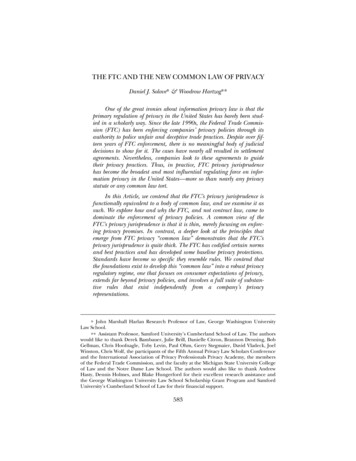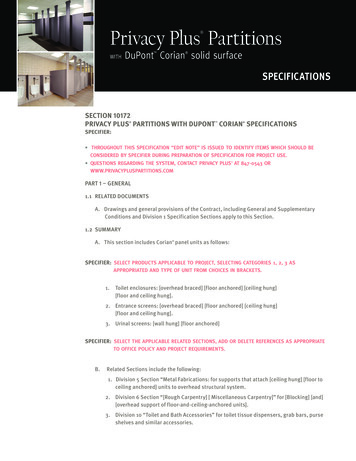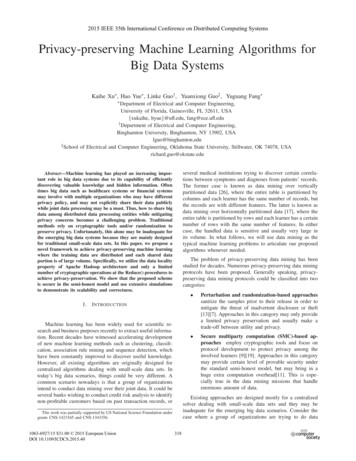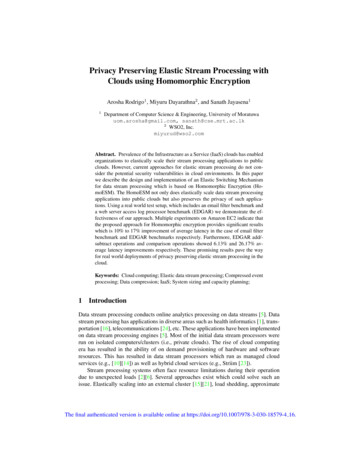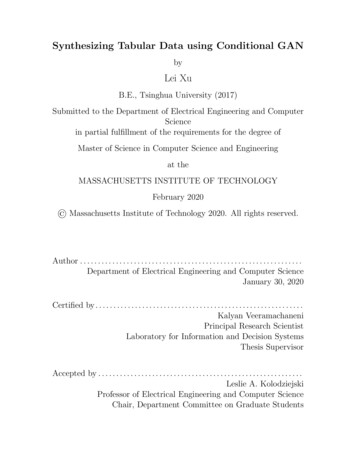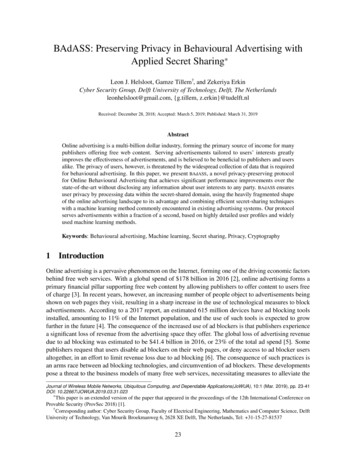
Transcription
BAdASS: Preserving Privacy in Behavioural Advertising withApplied Secret Sharing*Leon J. Helsloot, Gamze Tillem†, and Zekeriya ErkinCyber Security Group, Delft University of Technology, Delft, The Netherlandsleonhelsloot@gmail.com, {g.tillem, z.erkin}@tudelft.nlReceived: December 28, 2018; Accepted: March 5, 2019; Published: March 31, 2019AbstractOnline advertising is a multi-billion dollar industry, forming the primary source of income for manypublishers offering free web content. Serving advertisements tailored to users’ interests greatlyimproves the effectiveness of advertisements, and is believed to be beneficial to publishers and usersalike. The privacy of users, however, is threatened by the widespread collection of data that is requiredfor behavioural advertising. In this paper, we present BAdASS, a novel privacy-preserving protocolfor Online Behavioural Advertising that achieves significant performance improvements over thestate-of-the-art without disclosing any information about user interests to any party. BAdASS ensuresuser privacy by processing data within the secret-shared domain, using the heavily fragmented shapeof the online advertising landscape to its advantage and combining efficient secret-sharing techniqueswith a machine learning method commonly encountered in existing advertising systems. Our protocolserves advertisements within a fraction of a second, based on highly detailed user profiles and widelyused machine learning methods.Keywords: Behavioural advertising, Machine learning, Secret sharing, Privacy, Cryptography1IntroductionOnline advertising is a pervasive phenomenon on the Internet, forming one of the driving economic factorsbehind free web services. With a global spend of 178 billion in 2016 [2], online advertising forms aprimary financial pillar supporting free web content by allowing publishers to offer content to users freeof charge [3]. In recent years, however, an increasing number of people object to advertisements beingshown on web pages they visit, resulting in a sharp increase in the use of technological measures to blockadvertisements. According to a 2017 report, an estimated 615 million devices have ad blocking toolsinstalled, amounting to 11% of the Internet population, and the use of such tools is expected to growfurther in the future [4]. The consequence of the increased use of ad blockers is that publishers experiencea significant loss of revenue from the advertising space they offer. The global loss of advertising revenuedue to ad blocking was estimated to be 41.4 billion in 2016, or 23% of the total ad spend [5]. Somepublishers request that users disable ad blockers on their web pages, or deny access to ad blocker usersaltogether, in an effort to limit revenue loss due to ad blocking [6]. The consequence of such practices isan arms race between ad blocking technologies, and circumvention of ad blockers. These developmentspose a threat to the business models of many free web services, necessitating measures to alleviate theJournal of Wireless Mobile Networks, Ubiquitous Computing, and Dependable Applications(JoWUA), 10:1 (Mar. 2019), pp. 23-41DOI: 10.22667/JOWUA.2019.03.31.023* Thispaper is an extended version of the paper that appeared in the proceedings of the 12th International Conference onProvable Security (ProvSec 2018) [1].†Corresponding author: Cyber Security Group, Faculty of Electrical Engineering, Mathematics and Computer Science, DelftUniversity of Technology, Van Mourik Broekmanweg 6, 2628 XE Delft, The Netherlands, Tel: 31-15-27-8153723
Preserving Privacy in Behavioural Advertising with Secret SharingL.J. Helsloot et al.objections against online advertising in order to attain a sustainable advertisement-supported Interneteconomy.One of the objections people have against online advertising is the widespread data collection byadvertising companies, which infringes on user privacy [7]. In a recent survey among users of an adblocking tool, 32% of respondents indicated that privacy concerns were among the reasons for theiruse of an ad blocker [6]. A similar survey on privacy and advertising showed that 94% of respondentsconsidered online privacy an important issue, and 70% of respondents indicated that online advertisingnetworks and online advertisers should be responsible for users’ online privacy [8]. The widespreadcollection of user information that raises privacy concerns is a key element of behavioural targeting, inwhich a user’s browsing behaviour determines which advertisements are shown to the user. Althoughsuch behavioural advertising is recognized as being beneficial to both users and publishers, a mistrust ofadvertising companies and a lack of control hinders acceptance of behavioural advertising [7].1.1Online Behavioural AdvertisingOnline advertising is forming one of the driving economic factors behind free web services. With a globalspend of 178 billion in 2016 [2], online advertising forms a primary financial pillar supporting free webcontent by allowing publishers to offer content to users free of charge [3]. In recent years, however, anincreasing number of people object to advertisements being shown on web pages they visit, resultingin a sharp increase in the use of technological measures to block advertisements. According to a 2017report, an estimated 615 million devices have ad blocking tools installed, amounting to 11% of the Internetpopulation, and the use of such tools is expected to grow further in the future [4]. The consequence of theincreased use of ad blockers is that publishers experience a significant loss of revenue from the advertisingspace they offer. The global loss of advertising revenue due to ad blocking was estimated to be 41.4billion in 2016, or 23% of the total ad spend [5]. Some publishers request that users disable ad blockerson their web pages, or deny access to ad blocker users altogether, in an effort to limit revenue loss due toad blocking [6]. The consequence of such practices is an arms race between ad blocking technologies, andcircumvention of ad blockers. These developments pose a threat to the business models of many free webservices, necessitating measures to alleviate the objections against online advertising in order to attain asustainable advertisement-supported Internet economy.A major concern for the users is their privacy which is threatened by the widespread data collectionof advertising companies [7]. The collected data is used in behavioural targeting to determine whichadvertisements are shown to a user based on the user’s browsing behaviour. Although such behaviouraladvertising is recognized as being beneficial to both users and publishers, a mistrust of advertisingcompanies and a lack of control hinders acceptance of behavioural advertising [7]. In a recent surveyamong users of an ad blocking tool, 32% of respondents indicated that privacy concerns were among thereasons for their use of an ad blocker [6]. A similar survey on privacy and advertising showed that 94% ofrespondents considered online privacy an important issue, and 70% of respondents indicated that onlineadvertising networks and online advertisers should be responsible for users’ online privacy [8].The practice of showing advertisements based on previously exhibited behaviour is known as OnlineBehavioural Advertising (OBA). In OBA, user interests are inferred from data such as visited webpages, search queries, and online purchases. Based on these user interests, advertisements are typicallypersonalized using campaign-specific supervised machine learning models that predict users’ responsesto advertisements. Behavioural advertising greatly improves the expected advertising effectiveness bytargeting advertisements at individual users [9]. Users benefit from OBA by being served more relevantadvertisements, and advertisers can reach a specific desired audience by using accurate targeting. Moreover,publishers benefit from an increased value of their advertising space.OBA utilises the Real-Time Bidding (RTB) model of buying and selling advertisements [10]. RTB24
Preserving Privacy in Behavioural Advertising with Secret SharingL.J. Helsloot et al.facilitates real-time auctions of advertising space through marketplaces called ad exchanges (AdX),allowing buyers to determine bid values for individual ad impressions. The real-time nature of suchauctions, in which bids are to be placed in a fraction of a second, allows fine-grained control over allocationof advertising budgets, but also requires the whole auction process to be carried out programmatically.Along with ad exchanges, other types of platforms emerged to manage the added complexity of RTB.Demand-Side Platforms (DSPs) provide advertisers, who may not possess the expertise required toaccurately estimate impression values, with technologies to bid on individual impressions from multipleinventories. Likewise, Supply-Side Platforms (SSPs) support publishers in optimizing advertising yield.In existing literature, a number of methods is proposed to address privacy concerns in OBA. Thesemethods include blocking advertisements altogether [11], obfuscating browsing behaviour [12], andanonymization [13], as well as exposing only generalized user profiles to advertising companies [14].Limiting the data that is available to advertising companies, however, is expected to decrease the targetingaccuracy [15], and thus the value of advertisements to users, advertisers, and publishers. Other workproposes cryptographic approaches to aggregate click statistics [14] or select advertisements using securehardware [16]. These approaches, however, are based on advertising models in which centralized networksperform simple keyword-based advertisement selection, and as such are unsuitable for use within thehighly distributed RTB model. Recently, Helsloot et al. [17] proposed a protocol that uses thresholdhomomorphic encryption to preserve privacy in OBA within the RTB model. However, the use of expensivecryptographic operations throughout the protocol results in prohibitively large computational costs.In this paper, we present BAdASS, a novel privacy-preserving protocol for OBA that is compatible withthe RTB mechanism of buying ads and supports behavioural targeting based on highly detailed user profiles.BAdASS achieves significant performance improvements over the state of the art, using machine learningon secret-shared data to preserve privacy in OBA tasks. Our protocol uses the highly fragmented natureof the OBA landscape to distribute trust between parties, such that no single party can obtain sensitiveinformation. We achieve performance multilinear in the size of user profiles and the number of DSPs, andperform the highly time-sensitive advertisement selection task in a fraction of a second.In the rest of the paper, we summarize the preliminary methods in Section 2. In Section 3 weexplain BAdASS in detail. In Section 4 we provide the performance analyses for our protocol based oncommunication and computation complexity and real-time experiments. We analyze the security ofBAdASS in Section 5 and, we conclude the paper in Section 6.22.1PreliminariesLogistic RegressionLogistic regression is one possible technique for user response estimation which has been commonly usedby advertising companies such as Google [18], Facebook [19], and Criteo [20]. Given a d-dimensionalfeature vector x and model parameters w, it estimates the probability of a binary outcome using thesigmoid function:ŷ σ (w x) 1.1 e w x(1)In the concept of OBA, x contains the user profile while the binary output y indicates click or no click.Although a variety of machine learning algorithms has been proposed for user response estimation tasks,logistic regression has recently been used in production systems by many advertising companies, suchas Google [18], Facebook [19], and Criteo [20], and is considered a state-of-the-art model for responseprediction [21]. A logistic regression model is used to estimate the probability of a binary outcome y(click or no click) based on a d-dimensional predictor vector x (the user profile) [10]. Given a feature25
Preserving Privacy in Behavioural Advertising with Secret SharingL.J. Helsloot et al.vector x and model parameters w, the model predicts the click probability ŷ using the sigmoid function:The model parameters are updated as w w ηg using the gradient of the logistic loss g (ŷ y)x asin [18]. η in the update function is the learning rate which can be a constant or can be set to decay periteration and per coordinate of the gradient vector. After observing the actual binary click label y, weuse the gradient of the logistic loss to update model parameters w using an online Stochastic GradientDescent (SGD) method as in [18]. Given the gradient of the loss g (ŷ y)x, we perform the model updatew w ηg, where η is the learning rate. Note that the learning rate can be a constant, but may also be setto decay per iteration and per coordinate of the gradient vector.2.2Feature HashingThe feature space in logistic regression may become too large when categorical features with highcardinality are used. To avoid a high dimensional user vector, we use the hashing trick in [22] whichenables to map the user profile into a lower-dimensional vector x by setting xi to a count of the valueswhose hash is i. Many of the features considered in OBA are categorical. The high cardinality of some ofthese features results in a very large feature space, particularly if feature conjunctions are used. To encodecategories from a user profile into a vector of fixed dimensionality for use in logistic regression, we usethe hashing trick [22], which showed promising results in e.g. [20]. The hashing trick maps values fromour high-dimensional user profile into a lower-dimensional vector x by setting xi to a count of the valueswhose hash is i. The resulting d-dimensional vector x (in [20], d 224 is used) is the input feature vectorto the logistic regression model.2.3Shamir Secret SharingShamir’s secret sharing scheme [23] is a t-out-of-n threshold scheme in which a secret s Z p for a primep is shared among n parties, from which any subset of size at least t can reconstruct the secret. Weuse the notation ︀s̃︀ to indicate a (t,n) Shamir secret sharing of a value s, for some predefined t andn, and ︀ṽ︀ denotes an element-wise Shamir sharing of the vector v. Shamir’s secret sharing scheme isadditively homomorphic, such that ︀s1 ̃︀ ︀s2 ̃︀ ︀s1 s2 ̃︀. Parties holding shares of two secret values canthus compute shares of the sum of the two values, without interaction with other parties. Furthermore, apublic value c can be added to a shared secret s without interaction by adding c to each of the shares, i. e. ︀s̃︀ c ︀s c̃︀. Likewise, a shared secret can be multiplied with a public value c by multiplying each ofthe shares with c, i. e. ︀s̃︀ c ︀cs̃︀.Multiplication of the shares of two secret values s1 and s2 results in a (2(t 1),n) sharing of s1 s2 ,thus requiring 2t 1 shares to reconstruct the secret. Ben-Or et al. [24] describe a multiplication protocolin which the resulting polynomial is reduced to degree t 1 and randomized. Given a sharing of a value s,where ︀s̃︀i is held by party i, the degree reduction step is performed by each party splitting their share ︀s̃︀iinto a new (t,n) sharing ︀s̃︀i,1 ,., ︀s̃︀i,n . Each party i distributes their subshares among all parties, suchthat party j is given the subshare ︀s̃︀i, j . Each party j then combines the received subshares ︀s̃︀1, j ,., ︀s̃︀n, jinto a new share ︀s̃︀′j . The resulting sharing ︀s̃︀′ is a new (t,n) sharing of the value s. Gennaro et al. [25]simplify the degree reduction and randomization steps into a single step, requiring a single round permultiplication. Note that n needs to be at least 2t 1 for degree reduction to work.2.4Universal Re-encryptionUniversal re-encryption, presented as a technique for mix networks by Golle et al. [26], allows rerandomization of a ciphertext without access to the public key that was used during encryption. In BAdASS,we use the universal re-encryption technique presented in [26], based on a multiplicatively homomorphic26
Preserving Privacy in Behavioural Advertising with Secret SharingL.J. Helsloot et al.cryptosystem such as ElGamal [27]. We use the notation JxKu to denote the encryption of a value x underthe public key of user u using a universal re-encryption scheme.3Protocol DesignIn designing a privacy-preserving online advertising system, we aim to satisfy three goals. The first goalis to ensure profile privacy, such that information from which the interests of a user can be inferred is notrevealed to any party other than the user. Moreover, we aim to ensure model privacy, such that modelparameters used by a bidder are not revealed to any party other than the bidder. Finally, the system mustbe applicable to the RTB model and integrated into the online advertising landscape, allowing bidders toestimate the value of an ad impression based on historic observations.Our protocol is based on a semi-honest security model. Since some existing companies act as bothAdX and DSP, we assume that the AdX colludes with DSPs. To assist in privacy-preserving computations inthe presence of colluding parties, we introduce an additional entity into our setting called Privacy ServiceProvider (PSP). The PSP is not trusted with private data in unencrypted form, but is assumed to followthe protocol specification without colluding with any other party. We assume that targeting is performedonly by DSPs, such that DSPs are the only parties that operate on user data. The AdX only collect bids, andfrom these bids select the winner. SSPs only offer advertising space to multiple ad exchanges, and are notconsidered in our protocol.Parties collaboratively compute bid values based on a logistic regression model using secret-shareduser profiles and model parameters. We define a DSP group Γi to be a set of DSPs of size at least m 2t 1for a given reconstruction threshold t. Computations on behalf of a DSP γi, j Γi are performed entirelywithin Γi . In our protocol descriptions, any operations performed by DSPs on secret-shared values areassumed to be performed by all DSPs in a DSP group Γi . Plaintext values and encrypted values are generatedby the DSP responsible for the campaign on which computations are performed and, where necessary,published within Γi .BAdASS is divided into four different phases: user profiling, bidding, auction, and model update. Priorto protocol execution, advertisers set up campaigns such that DSPs can bid on their behalf, and the PSP splitsDSPs into groups of at least m parties. Moreover, each DSP shares campaign-specific parameters amongthe DSPs in their group. Finally, each user generates a key pair using any multiplicatively homomorphicasymmetric cryptosystem and publishes their public key. In the following subsections, we explain the fourphases of BAdASS. A summary of symbols used in the description of the protocol is provided in Table 1.3.1User Profiling PhaseTo preserve privacy during the user profiling phase, browsing behaviour is recorded locally within theuser’s web browser using an existing technique such as RePriv [28]. The resulting profile is captured in ad-dimensional feature vector x using feature hashing. To reduce the communication costs associated withsending the full d-dimensional feature vector for each request, feature vectors are cached at DSPs. Cachingallows periodic background updates of feature vectors, minimizing delays experienced by the user duringthe time-sensitive advertisement selection phase. To securely share a feature vector among DSPs withoutknowing the topology of the OBA landscape, the user splits their profile into two additive shares, one ofwhich is given to the AdX, the other to the PSP. Both the AdX and the PSP, in turn, create Shamir sharesfrom their additive shares, which are distributed among the DSP groups for which the profile update isintended. Every DSP within the group thus receives two Shamir shares, one from each additive sharecreated by the user, which are combined into a single Shamir share of the original value by calculating thesum of the two shares. The user profiling phase is illustrated in Protocol 1.27
Preserving Privacy in Behavioural Advertising with Secret SharingL.J. Helsloot et al.Table 1: Explanation of symbols used in BAdASSSymbolExplanationuvkΓiUnique user identifier.Unique bid request identifier.Unique campaign identifier.DSP group i.γi, jKΓixwkckηkbkakπ(x)π 1 ( )MUnique DSP identifier, where γi, j is the j DSP of DSP group ΓiSet of campaigns run by DSP group Γi .Input feature vector obtained by feature hashing.Model parameter vector for a campaign k, where wk,i is the ith coordinate of wk .Bidding function parameters for a campaign k.Learning rate parameter for campaign k.Bid value for campaign k.Advertisement associated with campaign k.Random permutation function, which re-orders the elements of vector x.Inverse permutation of π( ), such that π 1 (π(x)) x.List of vectors containing information associated with bid values for use in the auctionprotocol.thProtocol 1 Profile update protocol, executed jointly between a user, AdX, PSP and DSP group, and initiatedperiodically by every user.1: procedure USER : SEND - PROFILE - SHARE(x,u)2:Pick r R Zdp3: x 1 x r4: x 2 r5:invoke SHARE - PROFILE(u, x 1 ) at AdX6:invoke SHARE - PROFILE(u, x 2 ) at PSP7: end re SHARE - PROFILE(u, x m ) ︀ x m ̃︀ SHAMIR - SHARE( x m )for all γi, j Γi doinvoke DSP : COMBINE - PROFILE(u, ︀ x m ̃︀γi, j ) at DSP γi, jend forend procedureprocedure DSP : COMBINE - PROFILE(u, ︀ x m ̃︀)store ︀ x m ̃︀ for user uif ︀ x 1 ̃︀ and ︀ x 2 ̃︀ are both stored then ︀xu ̃︀ ︀ x 1 ̃︀ ︀ x 2 ̃︀end ifend procedureDepending on the feature hashing method used, the feature vector x is either binary or contains onlysmall values. Assuming the use of a binary feature vector, it would be ideal from the user’s perspective to28
Preserving Privacy in Behavioural Advertising with Secret SharingL.J. Helsloot et al.create additive shares of the feature vector in Z2 , rather than Z p , as smaller shares reduce the requiredcommunication bandwidth. Subsequent computations on the user profile, however, must be performedin Z p to represent real values with sufficient precision. In our setting with two additive shares, securelyconverting shares in Z2 to shares in Z p requires an invocation of the multiplication protocol for everyfeature vector dimension, resulting in high computation and communication costs for DSPs. We thereforefavour sharing the user profile in Z p .3.2Bidding PhaseThe bidding phase starts when a users contacts an AdX with an ad request. Receiving the ad request,AdX sends a bid request to DSP groups each of which cooperatively calculates the bidding prices forthe campaigns they are responsible for. For each campaign, the user response ŷ is estimated using alogistic regression model, and bidding values are derived from response estimations using linear biddingfunctions B(ŷ) c1 ŷ c2 for campaign-specific constants c1 and c2 . A challenge in logistic regression isto compute sigmoid function within the secret-shared domain. In existing literature the sigmoid functionis computed either by approximation [29, 30] or in clear [31, 32, 17]. In this work, we let the PSP computethe sigmoid function in the clear, as approximation leads to a degradation of predictive performance andincurs additional computational costs. The input to the sigmoid function w x is thus revealed to the PSP.In our setting, this is acceptable as the PSP knows neither the user, nor the campaign a value is associatedwith. Therefore, the PSP cannot infer any more information than that there exists a user who is interestedin a topic. Moreover, a DSP group could submit additional randomly generated values to mask real inputs.During the bidding phase, every DSP group cooperatively calculates bidding prices for each of thecampaigns the group is responsible for. When a user contacts an AdX with an ad request, the AdX sends abid request to every DSP group, each of which executes the bidding protocol.The sigmoid function that is used to make predictions in logistic regression models is non-trivialto compute within the secret-shared domain. In existing literature, two different approaches are usedto compute the sigmoid function: approximation [29, 30] or computation in the clear [31, 32]. Similarto [17], we let the PSP compute the sigmoid function in the clear, as approximation leads to a degradationof predictive performance and incurs additional computational costs. The input to the sigmoid functionw x is thus revealed to the PSP. In our setting, this is acceptable as the PSP knows neither the user, northe campaign a value is associated with. Therefore, the PSP cannot infer any more information than thatthere exists a user who is interested in a topic. Moreover, a DSP group could submit additional randomlygenerated values to mask real inputs.The bidding protocol is outlined in Protocol 2. The model parameters wk for campaigns k KΓi ,where KΓi is the set of campaigns run within Γi , and the user profile xu of a user u, are shared within Γi .The multiplications that are required for the calculation of the inner product of wk and xu in line 3 areperformed locally, without degree reduction. Since the results of these local multiplications are not usedin further multiplications, the sum of all multiplied values is a single sharing ︀sk ̃︀ of degree 2t 2. As thePSP subsequently collects and combines all m 2t 1 shares of sk , no degree reduction step is required incalculating w x.Since campaign parameters ck,1 and ck,2 are private to the DSP responsible for campaign k, they aresecret-shared among the parties in the DSP group. Calculation of the bid price bk ck,1 ŷk ck,2 thereforerequires a single invocation of the multiplication protocol for every campaign, which can be parallelizedsuch that all bid values are calculated in a single round of communication. To ensure profile privacy, eachadvertisement ak is encrypted using the user’s public key. The encrypted advertisement is submitted tothe PSP, via the AdX such that the PSP cannot link the submission to a specific DSP, along with a randomnumber rk and the group descriptor Γi . Finally, the PSP stores a mapping rk (Jak Ku ,Γi ), which is used inthe auction phase to retrieve the advertisement.29
Preserving Privacy in Behavioural Advertising with Secret SharingL.J. Helsloot et al.Protocol 2 Bidding protocol, executed jointly by a DSP group Γi and the PSP, and invoked by the AdX fora user u at every DSP group.1: procedure DSP : CALCULATE - BID({ ︀wk ̃︀, ︀ck ̃︀ ︀ k KΓi },u)2:for all k KΓi dod3: ︀sk ̃︀ ︀xu,i ̃︀ ︀wk,i ̃︀i .3Pick a unique random value rkStore mapping rk (Jak Ku ,Γi ) at PSP via AdXend forPick random permutation function π( ) ︀s′ ̃︀ π( ︀s̃︀)invoke ︀ŷ′ ̃︀ PSP : CALCULATE - SIGMA( ︀s′ ̃︀) at PSP ︀ŷ̃︀ π 1 ( ︀ŷ′ ̃︀)for all k KΓi do ︀bk ̃︀ ︀ck,1 ̃︀ ︀ŷk ̃︀ ︀ck,2 ̃︀end forend procedureprocedure PSP : CALCULATE - SIGMA( ︀s̃︀)s combine ︀s̃︀for all si s doŷi σ (si )end forreturn ︀ŷ̃︀end procedureAuction PhaseThe auction protocol uses a hierarchical auction in which each DSP group engages in a secure comparisonprotocol to select the highest of the bids within the DSP group, along with associated information that isused in the model update phase. Shares of the information associated with the highest bid are stored forlater use, after which each DSP group submits their highest bid to a global auction to select the final winner.Note that, due to the use of secret sharing, the global auction cannot be performed by the AdX alone. Inorder to maintain the same level of trust as in the bidding protocol, at least m parties are required in theauction protocol. Therefore, the global auction is not performed by the ad exchange, but by a randomlyselected DSP group Γ .The auction protocol is shown in Protocol 3. The protocol relies on a secure comparison protocolthat takes as input shares of two values a and b, and gives as output shares of 1 if a b, and shares of 0otherwise. Such a protocol is described by e. g. Reistad and Toft [33]. During the procedure to find themaximum bid, shares of the highest bid and additional information associated with the highest bid areobtained via multiplication with the result of the comparison. After the global comparison, shares of arandom identifier r associated with the highest bid are sent to the PSP, where the shares are combinedto retrieve the encrypted advertisement and group descriptor associated with the highest bid. To ensureunlinkability between the encrypted advertisement retrieved from the PSP after the auction and the valuessubmitted prior to the auction, the PSP performs re-randomization of the encrypted advertisement online 30 using universal re-encryption. Finally, the encrypted ad and the group descriptor, as well as the bidrequest identifier v, are sent via the AdX to the user, who decrypts and displays the advertisement.30
Preserving Privacy in Behavioural Advertising with Secret SharingL.J. Helsloot et al.Protocol 3 Auction protocol, executed jointly by every DSP group Γi , an auction group Γ , and the PSP.1: procedure DSP : PREPARE - AUCTION (v, ︀b̃︀, ︀r̃︀, ︀ŷ̃︀, ︀η̃︀, ︀k̃︀)2:for all Γi do3: ︀Mi ̃︀ ( ︀ri ̃︀, ︀ŷi ̃︀, ︀ηi ̃︀, ︀ki ̃︀)maxmaxmax( ︀bmax4:̃︀, ︀kimax ̃︀) MAX - BID( ︀bi ̃︀, ︀Mi ̃︀)i ̃︀, ︀ri ̃︀, ︀ŷi ̃︀, ︀ηimaxmax̃︀, ︀kimax ̃︀)5:Store mapping v ( ︀bmaxi ̃︀, ︀ŷi ̃︀, ︀ηi6:end for7:invoke PERFORM - AUCTION(v, ︀bmax ̃︀, ︀rmax ̃︀) at Γ 8: end procedureprocedure PERFORM - AUCTION(v, ︀b̃︀, ︀r̃︀)( ,
Online advertising is a pervasive phenomenon on the Internet, forming one of the driving economic factors behind free web services. With a global spend of 178 billion in 2016 [2], online advertising forms a primary financial pillar supporting free web content by allowing publishers to of
